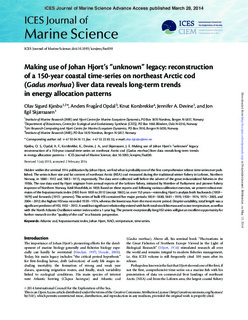Making use of Johan Hjort's “unknown” legacy: reconstruction of a 150-year coastal time-series on northeast Arctic cod (Gadus morhua) liver data reveals long-term trends in energy
Kjesbu, Olav Sigurd; Opdal, Anders Frugård; Korsbrekke, Knut; Devine, Jennifer A.; Skjæraasen, Jon Egil
Journal article, Peer reviewed
Date
2014-03-11Metadata
Show full item recordCollections
- Articles [3009]
Original version
Kjesbu, O.S., Opdal, A.F., Korsbrekke, K., Devine, J.A., Skjæraasen, J.E., 2014. Making use of Johan Hjort's “unknown” legacy: reconstruction of a 150-year coastal time-series on northeast Arctic cod (Gadus morhua) liver data reveals long-term trends in energy allocation patterns. ICES Journal of Marine Science: Journal du Conseil. DOI: 10.1093/icesjms/fsu030 10.1093/icesjms/fsu030Abstract
Hidden within the seminal 1914 publication by Johan Hjort, we find what is probably one of the first comprehensive teleost time-series ever published. The series is liver size and fat content of northeast Arctic (NEA) cod measured during the traditional winter fishery in Lofoten, Northern Norway, in 1880–1912 and 1883–1913, respectively. The data were collected well before the advent of the great industrialized fisheries in the 1930s. The raw data used by Hjort originate from annual reports of the Lofoten fishery, initiated by Member of Parliament and pioneer fishery inspector of Northern Norway, Ketil Motzfeldt, in 1859. Based on these reports and following various calibration exercises, we present robust estimates of the hepatosomatic index (HSI) from 1859 to 2012 (except 1863), i.e. over 153 years—extending Hjort's analysis both backwards (1859–1879) and forwards (1913–present). This series of bulk HSI contained five major periods: 1859–1880, 1881–1919, 1920–1974, 1975–2003, and 2004–2012; the highest HSI was recorded 1920–1974, whereas the lowest was from the most recent period. Despite variability, total length was a significant predictor of HSI, 1932–2012. A weak but significant relationship existed with both total-stock biomass and ocean temperature, as well as with the North Atlantic Oscillation winter index under a 1-year lag. The present exceptionally long HSI series will give an excellent opportunity for further research on the “quality of the cod” in a historic perspective.
